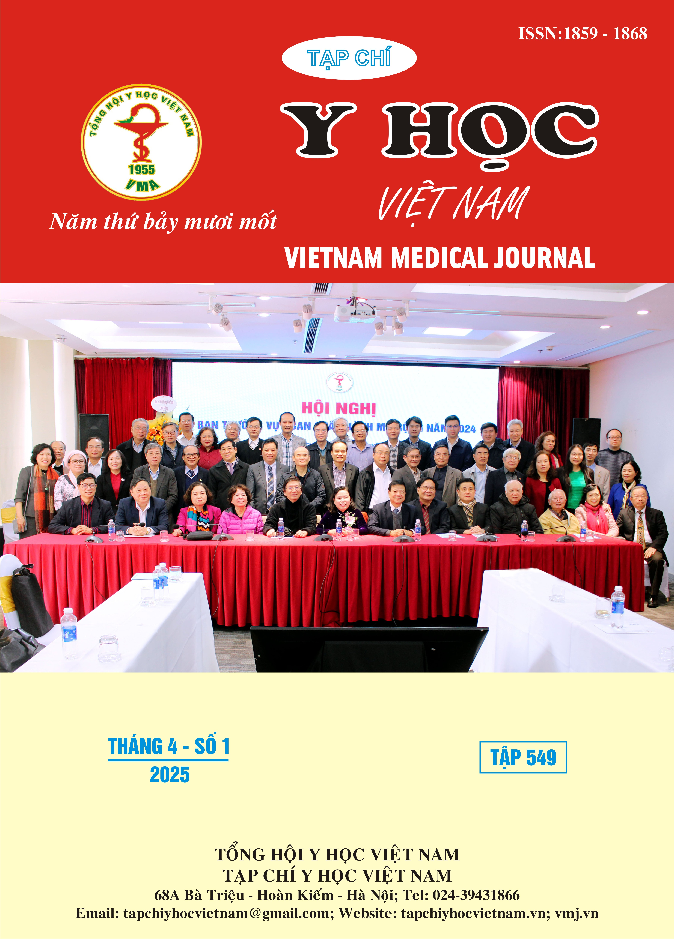KHẢO SÁT KIẾN THỨC, THÁI ĐỘ, THỰC HÀNH LIÊN QUAN ĐẾN NGUY CƠ MẮC BỆNH TIM MẠCH Ở NGƯỜI BỆNH RỐI LOẠN LIPID MÁU TẠI BỆNH VIỆN TRUNG ƯƠNG QUÂN ĐỘI 108
Nội dung chính của bài viết
Tóm tắt
Mục tiêu: Khảo sát kiến thức, thái độ, thực hành liên quan đến nguy cơ mắc bệnh tim mạch (Cardiovascular disease – CVD) ở người bệnh rối loạn lipid máu (RLLP) tại Bệnh viện Trung ương Quân đội 108. Đối tượng và phương pháp: Nghiên cứu mô tả cắt ngang trên 92 người bệnh RLLP từ tháng 05 năm 2024 đến tháng 10 năm 2024 phỏng vấn bằng bộ câu hỏi của Mohammad (2018). Kết quả: phân loại kiến thức: tốt chiếm 33,7%, trung bình 21,7%, kém 44,6%. Thái độ: tích cực chiếm 48,9%, tiêu cực 51,1%. Thực hành: tốt chiếm 30,4%, trung bình chiếm 38,0%, kém 31,6%. Có mối tương quan thuận giữa điểm trung bình kiến thức, thái độ và thực hành. Điểm kiến thức tăng tỷ lệ thuận với điểm thái độ (r = 0,623; p = 0,000), kiến thức và thực hành (r = 0,527; p = 0,000), thái độ và thực hành (r = 0,811; p = 0,000). Kết luận: Người bệnh RLLP có kiến thức, thái độ và thực hành liên quan đến nguy cơ mắc CVD còn thấp. Có mối tương quan thuận giữa kiến thức, thái độ và thực hành. Vì vậy, cần nâng cao nhận thức, tư vấn giáo dục sức khỏe cho người bệnh RLLP thấy được tầm quan trọng và mối nguy hiểm của CVD, giúp họ có kiến thức tốt từ đó hình thành thái độ tích cực và thực hành lành mạnh, trì hoãn khởi phát hình thành CVD.
Chi tiết bài viết
Từ khóa
kiến thức, thái độ, thực hành, bệnh tim mạch, rối loạn lipid máu
Tài liệu tham khảo
2. Lorber D. Importance of cardiovascular disease risk management in patients with type 2 diabetes mellitus. Diabetes Metab Syndr Obes.2014; 7:169-183.
3. Zhao D, Liu J, Wang M et al. Epidemiology of cardiovascular disease in China: current features and implications. Nat Rev Cardiol. 2019;16(4):2 03-212
4. Vaidya A, Aryal UR, Krettek A. Cardiovascular health knowledge, attitude and practice/behaviour in an urbanising community of Nepal: a population-based cross-sectional study from Jhaukhel-Duwakot Health Demographic Surveillance Site. BMJ Open. 2013; 3(10): p. e002976.
5. Mohammad NB, Rahman NAA, Haque M. Knowledge, Attitude, and Practice Regarding the Risk of Cardiovascular Diseases in Patients Attending Outpatient Clinic in Kuantan, Malaysia. J Pharm Bioallied SciJan. 2018; 10(1): 7-14.
6. Cholesterol Treatment Trialists’ (CTT) Collaboration, Baigent C, Blackwell L, et al. Efficacy and safety of more intensive lowering of LDL cholesterol: a meta-analysis of data from 170,000 participants in 26 randomised trials. Lancet. 2010;376 (9753): 1670-1681.
7. Goldman RE, Parker DR, Eaton CB et al. Patients' perceptions of cholesterol, cardiovascular disease risk, and risk communication strategies [published correction appears in Ann Fam Med. 2006 Jul-Aug;4(4):371]. Ann Fam Med. 2006; 4(3): 205-212.
8. Khan SS, Ning H, Wilkins JT et al. Association of Body Mass Index With Lifetime Risk of Cardiovascular Disease and Compression of Morbidity. JAMA Cardiol. 2018; 3(4): 280-287.
9. Gallucci G, Tartarone A, Lerose R et al. Cardiovascular risk of smoking and benefits of smoking cessation. J Thorac Dis. 2020; 12(7): 3866-3876.
10. Smart NA, Downes D et al. The Effect of Exercise Training on Blood Lipids: A Systematic Review and Meta-analysis. Sports Med. 2024.


